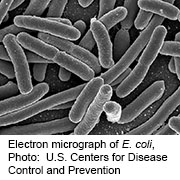
Scientists have identified a new patient who carried a type of bacteria that is resistant to an antibiotic of last resort, bringing the number of cases reported in the United States to four.
All of the patients had E. coli with a gene called mcr-1, which makes the bacteria resistant to the antibiotic colistin, according to the U.S. Centers for Disease Control and Prevention.
The latest case, a 2-year-old Connecticut girl, was diagnosed in June after she returned from a trip to the Caribbean, said senior researcher Maroya Spalding Walters, a CDC epidemiologist.
“The girl had an illness that caused diarrhea, which began in mid-June while she was traveling overseas. Her diarrhea was not caused by the bacteria that had the mcr-1 gene — the cause has not been definitively diagnosed,” she said.
Although the mcr-1 gene was found, it wasn’t producing toxins. When the girl got better, the bacteria that contained the gene disappeared within a week of her recovery, Walters said.
Similar cases have been reported in Pennsylvania and New York.
Fortunately, none of these infections has spread beyond the original patient, Walters said.
Still, mcr-1 is resistant to colistin, which is reserved to treat severe infections that are resistant to other antibiotics, she added.
“We have seen colistin resistance in the past, but what makes this mcr-1 gene so important is that it can be transmitted between different types of bacteria,” Walters explained.
“The concern is that it could move into bacteria that are already highly resistant and could render them resistant to all antibiotics, but we have not seen this in the U.S.,” she said.
It has been seen in other parts of the world, however. Walters said mcr-1 itself is susceptible to many other antibiotics.
The E coli bacteria containing the mcr-1 gene have been found in farm animals, but it isn’t clear how people get the bacteria, Walters said. It has also been found in hospitals, so it might be transmitted in that setting.
E. coli with the mcr-1 gene is still rare in the United States, “but it’s something we continue to look for,” Walters said.
“We are never going to completely halt the spread of mcr-1, but we want to limit it,” she said. The idea is to keep track of it. So far, it hasn’t gone from person to person, she added.
“Bacteria will continue to develop new forms of resistance, so we have to preserve the antibiotics we have by not overusing them,” Walters said.
The findings were published Sept. 9 in the CDC’s Morbidity and Mortality Weekly Report.
More information
Visit the U.S. Centers for Disease Control and Prevention for more on antibiotic resistance.
Source: HealthDay

Leave a Reply